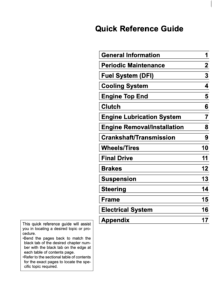Complete PDF version of the Service Manual for the Kawasaki Ninja ZX6RR. A MUST for every ZX-6RR owner.
Download: Immediately after payment!
OEM Original factory workshop manual.
Models covered by this manual: 2005 to 2006
Number of pages: 563 pages
Table of contents:

This PDF repair manual can be downloaded right after the payment process in complete, on the device of your choice.
We do not offer printed manuals, for the following reasons:
- it is more eco-friendly to use a digital version
- your manual never gets dirty or greasy
- you can always choose to print the specific page(s) you need to work on your bike
- you receive your manual immediately after payment
- it is searchable
Kawasaki Ninja ZX6RR
The Kawasaki Ninja ZX-6R is a 600cc class motorbike in Kawasaki‘s Ninja sport bike series. It was first presented in 1995 and has since been regularly upgraded in response to new models from Honda, Suzuki, and Yamaha. In the 1980s, the ZX series was known as the Ninja line of Kawasaki bikes, and it still bears that moniker today.
Kawasaki released the ZX-6R in 1995, with very similar appearance and characteristics to the ZX-9R introduced in 1994, including the ram-air intake that Kawasaki had developed since the 1990 ZX-11 (ZZ-R1100). The original ZX-6R weighed 401.2 lb (182.0 kg) dry, 454 lb (206 kg wet), and could accelerate from 0 to 60 mph (0 to 97 km/h) in 3.6 seconds. After four years of selling a 636 cc ZX-6R for street usage and a separate 599 cc ZX-6RR for displacement-restricted racing classes, Kawasaki only produced one ZX-6R in 2007. It displaced 599 cc.
The engines in previous years of the ZX-6R were all produced from the same basic design, but the all-new engine for 2007 was completely reworked from the crankcase up. Following in the footsteps of its competitors, Kawasaki’s new engine featured a stacked gear configuration with the crankshaft, primary drive, and countershaft arranged in a triangle structure for a shorter, more compact powertrain. It is now around 40 mm shorter in both length and breadth, and it is believed to provide more cornering space. Kawasaki states that by employing a former 125 cc Grand Prix racer as the ZX-6R’s head development rider, Tomomi Manako, an emphasis on track usage has been placed. The frame, swingarm, suspension, brakes, and body were all totally overhauled, and the bike has very few elements in common with the previous model. The color design of the ZX-6R was carried over to the 2008 model year.
Kawasaki updated the ZX-6R once again in 2005. The engine speed was increased by 1,000 RPM again, culminating in 113 horsepower (84 kW) at 12,250 RPM. The frame and swingarm were modified, but the biggest differences between it and its predecessor were in the design. The aluminum frame was now flat black, the fairings were rounded, and integrated turn signals were employed (euro model). The exhaust was now located in the center of the seat (a configuration commonly referred to as an undertail exhaust). The majority of these improvements were carried over to the 599 cc ZX-6RR. The ZX-6RR won the Supersport category and finished third overall in Masterbike 2005 for the second year in a row. Minor suspension improvements and new color schemes were made to the bike for the 2006 model year.
Source: Wikipedia


